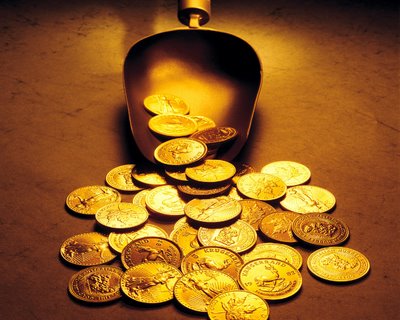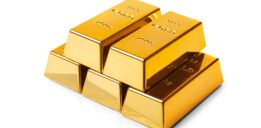Best Gold Royalty Stocks
Gold has entered a new bull run, but the best way to take advantage of the long-term growth potential of gold is not with bullion or gold mining stocks. Instead, the greatest way to capitalize on bullion’s upside potential in 2017 and 2018 is with the best gold royalty stocks.
Instead of getting their hands dirty exploring and mining, gold royalty trust stocks essentially finance currently existing mining projects in return for a portion of future revenue.
After years of trading lower, gold bullion entered a new bull market in 2017. While this is just the second gold bull market in the last 37 years, the 2017 gold bull market is in its infancy and should provide investors with huge gains over the next few years.
|
Company |
Ticker |
|
Anglo Pacific Group plc |
LON:APF |
|
Agnico Eagle Mines Ltd |
NYSE:AEM |
|
Franco Nevada Corp |
TSE:FNV |
|
Osisko Gold Royalties Ltd |
NYSE:OR |
|
Osisko Gold Royalties Ltd |
TSE:OR |
|
Royal Gold, Inc |
NASDAQ:RGLD |
|
Sandstorm Gold Ltd |
NYSEMKT:SAND |
|
Silver Wheaton |
SWX:SLW |
The most recent gold bull market ran from November 2000 to September 2011. Over that period of time, gold prices increased 625% from approximately $265.00 per ounce to over $1,920 per ounce.
Chart courtesy of StockCharts.com
After peaking in September 2011, gold prices retreated as economic indicators suggested that the U.S. economy was getting stronger. As a hedge against economic uncertainty, gold took a back seat to stocks.
That uncertainty returned in early 2016 though, as investors digested fears of a global recession and concerns that the U.S. Federal Reserve had prematurely raised its key lending rate in December 2015, the first such (modest) increase in almost a decade.
Also Read: Gold Price Forecast 2017
It turns out the so-called positive economic indicators were hiding serious problems with the U.S. economy. By August 2016, gold prices had climbed almost 30%, to around $1,060 per ounce. Gold and silver prices experienced some profit taking in the fall, and took a further hit after Donald Trump won the November presidential election.
Wall Street, which was initially dubious of Donald Trump’s election promises, decided that his pro-growth, pro-business tax cuts and increased spending would be good for the U.S. economy and corporate profits. Again, as a hedge against economic uncertainty, this was a bad combination for gold. Gold started 2016 strong, but ended the year up just 8.5%, at $1151.70 per ounce.

Credits: Flickr.com/miong
The price of gold experienced a renaissance at the beginning of 2017, sending the precious metal into a bull market that is expected to last for years. Why the change in sentiment? Trump’s pro-growth strategies have been embraced by most Americans, but no one is certain he can get his campaign promises enacted. This has created uncertainty.
Moreover, if Trump can’t get his tax cuts and planned infrastructure spending passed, it will put a serious dent in his promise to get U.S. annual gross domestic product (GDP) to four percent.
The U.S. economy is busy creating lots of low-paying, part-time jobs. Meanwhile, the U.S. economic recovery is trudging along at its slowest pace since World War II. During his presidency, Barack Obama never registered a single, solitary, year of three percent GDP growth. In his last year of office, GDP was just 1.6%. In the first quarter of 2017, U.S. GDP grew by a paltry 0.7%, the weakest growth in three years.
Despite ongoing optimism about Trump’s economic action plan, there is growing concern that Trump will not be able to achieve his campaign pledge of four percent GDP growth. If GDP growth is weak, it will be hard to justify the outrageous valuations on stocks.
There needs to be a catalyst to send stocks higher. If one doesn’t present itself, investors will get nervous and impatient, and the bull market—like the U.S. economy—could grind to a halt. All of which is bullish for gold prices.
There are a number of reasons why the gold bull market will gain steam in the second half of 2017, including political stalemate in Washington, weak U.S. economic indicators, inflation, and ongoing geopolitical tensions between the U.S. and North Korea, Syria, and Iran.
No one really knows what Trump’s trade tariffs will do either. We know he’s not afraid to implement them; he just placed a 20% tariff on Canadian lumber. If he’s going to do that with his largest trading partner, who knows what he’ll end up doing with China and Mexico. Any kind of serious trade war would have serious implications on the U.S. economy and stock market.
This isn’t a flat-out contrarian outlook on the economy. Even the central banks are not sure we’re out of the woods, economically. In 2010, central banks from around the world went from being net sellers to net buyers of gold.
Following the U.S. financial crisis, central banks started to accumulate gold as a hedge against economic and political uncertainty. They also bought gold to back up their currencies so they can compete against the U.S. dollar, which is the world’s reserve currency.
If the world’s biggest economy isn’t immune to economic collapse, how safe is the U.S. dollar? In an effort to be more self-sufficient and less dependent on the U.S. dollar, central banks are buying more and more gold.
What are the best ways to invest in gold? There are a lot of different ways to play the gold bull market. Investors love physical gold, gold mining exchange-traded funds (ETFs), and upside potential of gold mining stocks, but one of the best ways to play gold is with royalty and streaming companies.
Gold Royalty Companies
Gold royalty and streaming companies are essentially mine-financing entities that sell shares to investors. Royalty companies provide money to gold and silver mining companies to help pay for exploration or capital costs. You could view a gold royalty company as a private banker to gold mining companies.
Instead of charging gold mining companies an interest rate on the money they provide, gold royalty companies receive one of two types of royalty payments. In the first scenario, a gold royalty company will finance an exploration program and receive a royalty on any future sales that come from the discovery.
The upfront payments might only be a few million dollars, and the return could be as low as one percent to five percent of sales. But, depending on the reserves and production levels, the ongoing royalty payments can be massive and go on for decades.
In the second scenario, a gold royalty trust will help finance the construction of the mine. This is very labor-intensive, and takes a lot of money. The company will receive a royalty payment called a stream for either a certain number of ounces of gold per year or a certain percentage of ounces produced on an annual basis.
Under this agreement, a royalty company might be able to buy streams of gold at a 75% discount to the current spot price. While this is a big discount, it’s the easiest way for the gold mining company to repay the gold royalty trust. It’s also a great way for gold royalty companies to earn solid income streams.
Whereas a gold mining company might be pinning their long-term hopes of success on one, two, or three mines, a gold royalty trust is much more diversified. The biggest and best gold royalty companies might have a portfolio of anywhere from 10, 15, 25, or 50 different mines from which they receive royalties and stream.
Also Read: Precious Metal Analysis: Keep Gold and Silver on Your Radar in 2017
So, if a gold mining company with three mines encounters unexpected problems, its share price could very easily plunge 20% to 50% or more in a single day. But, because a gold royalty trust stock is diversified across many mines, its share price will not be as volatile or fluctuate as much, even if it has a royalty on the gold mine that reported bad news. The royalties and streams from the other gold mines ensure a steady revenue stream.
The best gold royalty streaming companies don’t just help fund smaller gold mines. Some of the best gold royalty companies help finance some of the biggest gold mining stocks in the world.
Another big benefit of owning gold royalty company shares is that they generally pay much higher dividends than even the biggest gold mining companies. That’s because they have low overhead and few employees. When their royalty income rolls in, the vast majority of it—normally over 90%—goes to gross profits (which includes dividends and taxes) and helps finance future projects.
Royalty and Streaming Stocks
Saying that gold royalty stocks are even better than gold mining stocks is really saying something. For example, if it costs a gold mining company $700.00 to mine an ounce of gold, and physical gold is selling for $1,000 an ounce, that gold company realizes a profit of $300.00.
Now, if gold rises to $1,300 an ounce, that gold mining company makes a profit of $600.00 on each ounce of gold. That means the gold mining company sees a 100% increase in profits off of a 30% increase in gold prices.
With that said, here are some of the best royalty and streaming companies.
Silver Wheaton (SWX:SLW) is the largest precious metal streaming company in the world. The company derives approximately 60% of its revenue from the sale of silver, and approximately 40% of its revenue from the sale of gold. (Source: “Why Invest in Silver Wheaton?,” Silver Wheaton Corp., last accessed May 11, 2017.)
Silver Wheaton has entered into 20 precious metal purchase agreements with 15 operating partners, including Vale SA (ADR) (NYSE:VALE), Barrick Gold Corp (NYSE:ABX,) and Goldcorp Inc. (NYSE:GG).
The price that Silver Wheaton pays for production averages approximately $400.00 per ounce of gold and $4.00 per ounce of silver (with a small inflationary adjustment, ensuring that Silver Wheaton’s costs are fixed).
Sandstorm Gold Ltd (NYSEMKT:SAND), is based in Vancouver, British Columbia, Canada and has, since 2009, acquired a portfolio of 155 streams and royalties. Twenty of its underlying mines are producing. A stream allows Sandstorm to purchase a portion of a mine’s gold production at a fixed rate. (Source: “Key Streams and Royalties,” Sandstorm Gold Ltd., last accessed May 11, 2017.)
For example, the Santa Elena mine, which is owned by First Majestic Silver Corp (NYSE:AG), is located in Northern Mexico. Santa Elena began as an open pit operation and transitioned to underground mining in early 2014. First Majestic has projected Santa Elena to produce 4.6 to 5.1 million ounces of gold equivalent in 2016. (Source: “Santa Elena,” Sandstorm Gold Ltd, last accessed May 11, 2017.)
Sandstorm has an agreement to purchase 20% of the life-of-the-mine gold production for a per-ounce cash payment equal to the lesser of $357.00 per ounce and the then-prevailing market price of gold. Sandstorm made an upfront payment of $12.0 million in cash and 700,000 shares to acquire the stream.
In February 2014, Sandstorm exercised its underground mine option allowing the company to purchase 20% of the payable gold from underground. For consideration, Sandstorm made a $10.0 million payment and will continue to make ongoing per-ounce payments equal to $357.00 until 50,000 ounces of gold have been delivered to Sandstorm. After which, the ongoing per-ounce payments will increase to $450.00.
Denver, Colorado-based Royal Gold, Inc (NASDAQ:RGLD) has a gold-focused portfolio of 38 producing and 22 development-stage royalties. Approximately 77% of Royal Gold’s fiscal 2016 revenue (a record $360.0 million) derived from its principal producing properties, including Mount Milligan, Andacollo, Pueblo Viejo, Wassa and Prestea, Peñasquito, Holt, and Cortez. (Source: “Principal Properties,” Royal Gold, Inc, last accessed May 11, 2017.)







